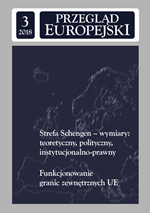The Schengen Area as an illustration of the Late Westphalian order
The Schengen Area as an illustration of the Late Westphalian order
Author(s): Anna MoraczewskaSubject(s): Politics / Political Sciences, Politics, Law, Constitution, Jurisprudence, Political Sciences
Published by: Wydawnictwa Uniwersytetu Warszawskiego
Keywords: post-Westphalian order; borders; Schengen zone; change; uncertainty; vacillation; ład późnowestfalski; granice; strefa Schengen; zmiana; niepewność
Summary/Abstract: States, sovereignty, territory, international law and derivatives of them are classical elements creatinginternational space. Borders are their keystones, that organise the international space, and any changesin their position, structure or rules of crossing, result in huge consequences for a political order. Determinants of, the so called, post-Westphalian order: variability, uncertainty and pluralism of possibilities,destroy a shaped structure and mechanisms of relations between these elements. Changes in the rules andmeans of activity often bring a deficit of effective reactions and uncertainty. The essence of borders hasalso transformed in: a redefinition of division between the interior and external environments of the state,replacing a perception of the border in terms of barriers to the bridge and extending border control practiceswith the concept of border management. The Schengen area is an exemplification how borders “work”in the post-Westphalian order. They are redefined in their external and internal functions, and are manifestations of volatility, uncertainty and contradictions. Since 1985, the zone has developed in territorial and legaldimensions, passing through stages of introduction, growth, maturity, and decline, which does not mean theend of Schengen area, but uncertainty about conditions of its operation in the post-Westphalian order, whichcan be called a vacillation of borders. The present stage of Schengen may also represent a turning pointin its development, called conversion and leading to its fundamental change.
Journal: Przegląd Europejski
- Issue Year: 2018
- Issue No: 3
- Page Range: 45-67
- Page Count: 23
- Language: English

